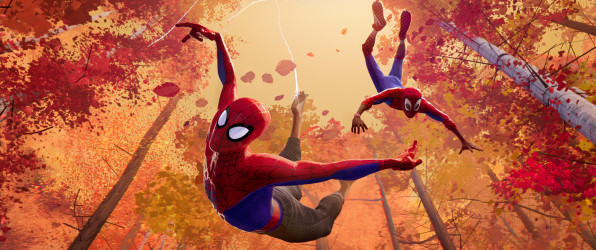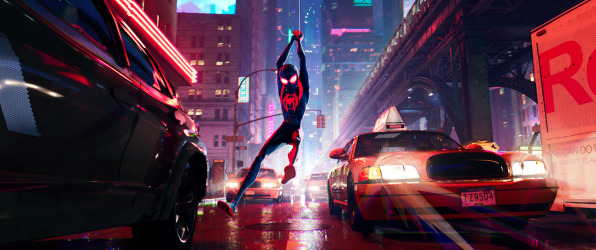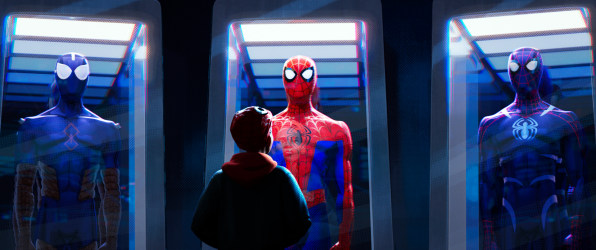What Was Into The Spider Verse Animated With
Phil Lord was at a Jeff Koons exhibit in New York when inspiration struck: What would a mail-modernistic Spider-Man look like? The franchise has seen a dizzying array of sequels and reboots since Tobey Maguire'south 2002 turn every bit the webslinger. So, with the superhero market place every bit swollen as it is, the challenge for Lord and filmmaking partner Christopher Miller became this: How exercise nosotros brand an iconic, if somewhat stale, character feel fresh in a new movie?
The respond became animation done like nothing else. Today, that vision for Spider-Man: Into the Spider-Poetry hits screens with another groundbreaker: the film debut of Miles Morales, an Afro-Puerto Rican teen who assumes the Spider-Man mantle later Peter Parker dies.
"Chris and Phil wanted to exercise something that they had never seen before—so pretty lofty goals from the beginning," Danny Dimian, the visual effects supervisor on Spider-Verse, says of the coproducers who wrote and directed The Lego Flick. "Early, we embraced the idea of, 'it'due south not cleaved, break it.' That was something nosotros joked most to try and costless artists from feeling as well uncomfortable to try something that there wasn't an firsthand style to do information technology."
In Spider-Poesy, Morales gains his powers (through a spider bite, of grade) only as Spider-Man'due south nemesis Kingpin is launching a machine that can tap into multiple universes. When the technology malfunctions, parallel universes start colliding, and with that, three other Spider-Men, a Spider-Woman, and a Spider-Pig wind upwardly in Morales'southward timeline. The casting of Morales has been a buzzy, not to mention diverse, add-on to the franchise, giving it new energy.
Dimian, who describes himself as the head autobus for the team of artists and engineers, breaks down the creative magnitude of Spider-Poetry and why an animated addition to the predominately live-action franchise is of import.

"In the beginning, it was really merely trying all kinds of crazy ideas," Dimian says. "Just not worrying and so much about whether it would all come together and whether information technology would wait right, simply absolutely trying things that were new for the sake of merely seeing what it might do."
The final look of the picture show became a gorgeous blend of CG and hand-drawn animation with the aim of imitating the fine art of comic volume illustrations. The blitheness team even went so far as to replicate color offsets, printing errors in comic books that tin can make a panel expect like it's slightly out of focus. Rethinking what an animated moving picture could await like was no minor social club. In a regular animated film, information technology would take an artist about a calendar week to animate four seconds of film. For Spider-Verse, it took each artist one week to animate one 2d.
"When you paint something, it'south only artwork–you can kind of do anything you want. But when yous move information technology, then that'southward where all of your issues and all your problems first," Dimian says. "The more abstract you are, the more stylized y'all are, the more than that you're going to have to start solving things."

Dimian and his team'southward workarounds were more than like inventing new strategies and pipelines they've never tried before. For example, to drill into having more of a raw, less perfect look, the team decided not to utilise motion blur, an effect in computer animation that blurs frames to imitate an image captured from a rapidly moving camera. And animation for Into the Spider-Verse was washed on twos (i.e., 12 frames per second instead of 24). Information technology'due south a rare creative pick in CGI that caused a chip of roadblock during animation tests.
"If you're animative on twos, yous have one frame where you are moving and and then another frame where y'all're not moving at all. And then you lot move again. From a simulation point of view, that's the equivalent of stopping and starting, like 0 to 100 every time–simulations don't like that," Dimian says. "So, for simulation purposes, we had to accept the pipeline rewritten so the animation team could animate the way they want. And and so under the hood, the pipeline then tries to translate the information that is meaningful for a simulation."
In improver to technical trouble-solving, going into a project with so much leeway presently became a necessary process of self-editing. The climactic battle between Kingpin and his cronies versus all six Spider-Men is a trip to say the least. Not only is the fight choreography intensely frenetic, the action is happening every bit Kingpin'south machine is melting all the parallel universes together, resulting in an explosion of colors and objects clashing together. Balancing all the higher up with several emotional moments peppered throughout the fight scene was a tight-rope act for Dimian and his squad.
"Because there were and then many things that we were trying, a lot of this movie was actually left pretty open and fluid," Dimian says. "For example, the concluding boxing actually went through fifty-fifty more color transitions and changes, but it started getting too confusing and kaleidoscopic. The danger is always that you lot're doing something that is and so visually interesting but doesn't serve the story."

All the creative decisions backside Into the Spider-Verse has made it truly a singular movie in blitheness. Dimian acknowledges that even with some of the restraint they exercised, there's the possibility of audiences beingness turned off past something so new.
"We merely decided we are trying to come up up with a new linguistic communication. And any time someone is learning a new language–and in this case the audience is learning the language with usa–in that location'due south going to be a lilliputian bit of a learning curve on it," he says. "But we decided to become big because the story is then potent that people volition get into it, hopefully."
Ultimately, Dimian hopes Spider-Verse will inject a fresh perspective on the Spider-Homo franchise and to animation every bit a whole.
"We're not beholden to whatsoever of the logical questions you might accept if yous're doing a live-activity version," Dimian says. "Then, if we got it right, we would take the all-time of a lot of things where we were gratis to exist more than crazy but still have the same bear upon and the aforementioned blockbuster feel."
Source: https://www.fastcompany.com/90280617/inside-the-animation-magic-of-spider-man-into-the-spider-verse
Posted by: maserneash1938.blogspot.com

0 Response to "What Was Into The Spider Verse Animated With"
Post a Comment